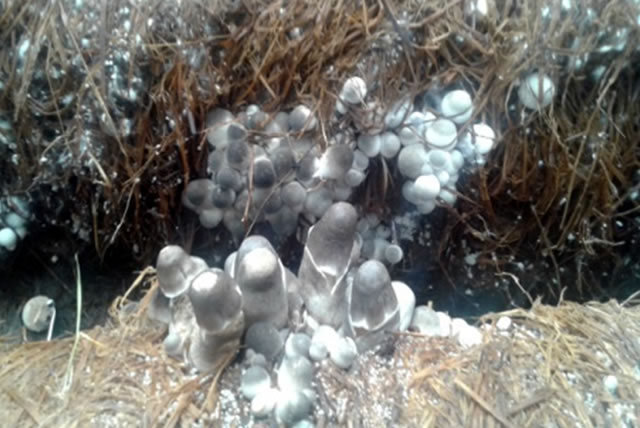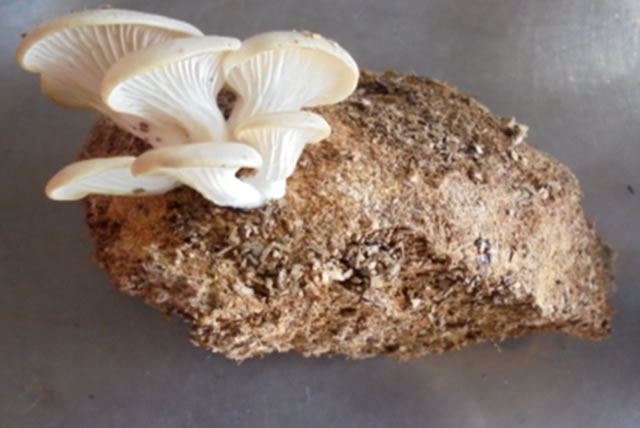Off-field rice straw management
With developments in the technologies for its collection and utilization, rice straw is increasingly removed from the fields to be used for better purposes such as for mushroom and energy production and for cattle feed.
Rice straw collection
Collecting rice straw is still a major challenge in the rice straw supply chain. Upon being gathered from the field, bundles of rice straw need to be compressed into bales to make them compact to reduce the transportation cost. With the introduction of combine harvesters that tend to leave the rice straw in the field, collecting rice straw has become even harder and more costly.
Collection of rice straw involves three main operations: picking up of rice straw materials, compacting them into bales, and hauling them to a storage or processing area. In these activities, a collecting machine, called a baler, is the main compacting unit (baling). The baler sometimes includes the other two operations—picking up of straw and hauling of baled material—which depend on operational conditions and purposes. A stationary baler with only a compaction unit can be used properly in collecting straw disposed from paddy threshers. On the other hand, a mobile baler (either self-propelled or pulled by a tractor) is suitable for collecting rice straw left in the field by combine harvesters. There are two main classifications of a baler defined by the principle of operation of the compacting unit. The piston-type is used in making square bales (Figure 1a), whereas the roller-type is applied to make round bales (Figure 1b).
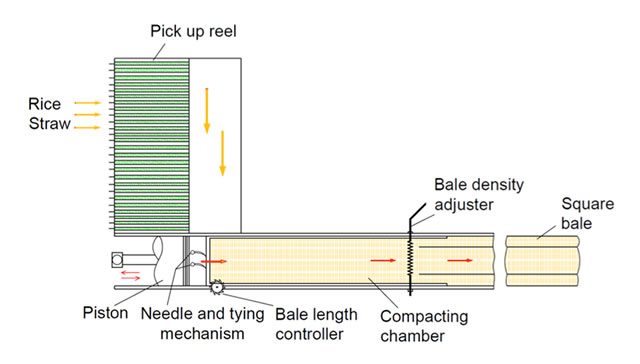
Figure 1a. Piston-type rice straw baler.
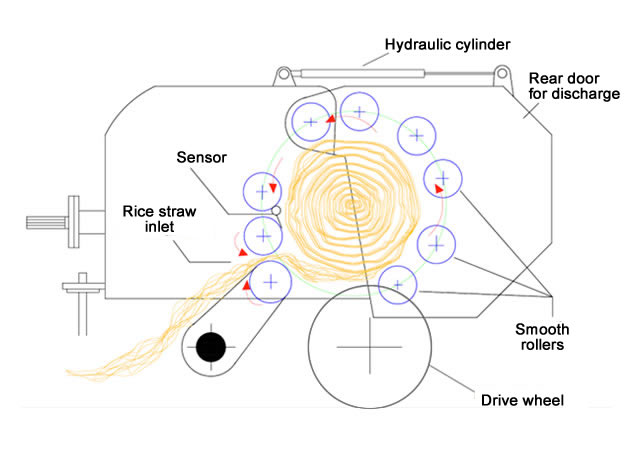
Figure 1b. Principle of a roller-type rice straw baler.
In 2016, we conducted a study on straw collection in the Mekong River Delta of Vietnam to evaluate and demonstrate the use of the machines for collecting straw. This study involved 3 types of machines: a roller baler pulled by a tractor (Figure 2a), a self-propelled baler (Figure 2b), and a self-propelled loose straw-gathering machine (Figure 2c). The baler pulled by a tractor can only bale and release straw bales in the field, thus bundles of baled straw need to be collected and transported to the bund in a separate operation. Different from this baler, the self-propelled machines bale and also bring the baled rice straw to the bund. The gathering machine only gathers rice straw in loose form but does not bale the straw.
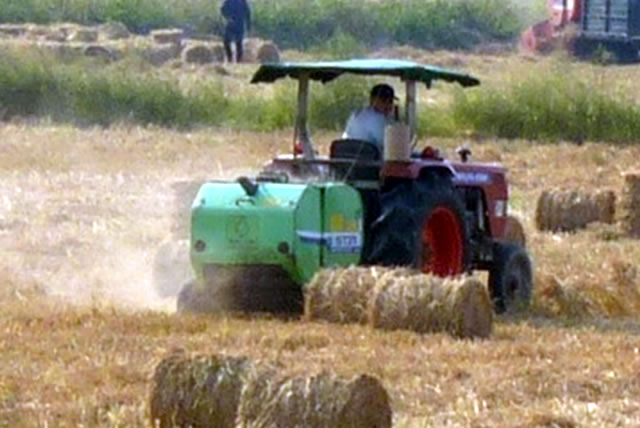 |
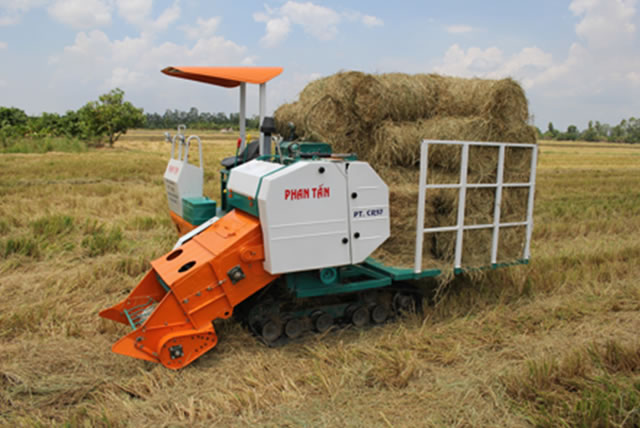 |
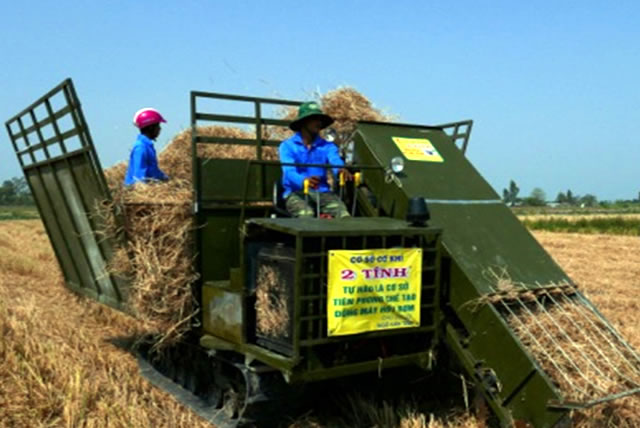 |
| Figure 2a. Roller baler pulled by a tractor. | Figure 2b. Self-propelled baler. | Figure 2c. Gathering machine (loose rice straw). |
This study showed that the collecting machines operated with a capacity of 0.87–2.47 tons per hour. Straw bales collected by the balers had specific weight of 73–104 kg per cubic meter at a moisture content of 12%. Total energy consumption ranged from 351 to 588 MJ per ton of straw transported to the field bund. This energy consumption caused GHGE from 60 to 165 kg CO2 equivalent per ton of the straw collected. The cost of collection ranged from USD 12 to USD 18 per ton of straw in the Mekong River Delta of Vietnam.
Non-energy uses of rice straw
This section provides an overview of three popular uses of rice straw in the agriculture sector, particularly in mushroom, biochar, and animal fodder production.
Using rice straw for mushroom production
Mushroom cultivation is a profitable agri-business endeavor that produces food from rice and wheat straw while facilitating the proper disposal of this by-product in an environmentally friendly manner. The paddy straw mushroom, Volvariella volvacea (Figure 3a), is considered to be one of the easiest mushrooms to cultivate because of its short incubation period of 14 days (Reyes 2000). Using rice straw for mushroom production can yield about 5–10% of mushroom products (50–100 kg of mushroom per 1 ton of dried straw) (Zhang et al 2002 and Ngo 2011). On the other hand, cultivation of the oyster mushroom Pleurotus spp. (Figure 3b) offers an on-farm technology for the bioconversion of poor-quality straw into nutritious food products.
Biochar production and utilization
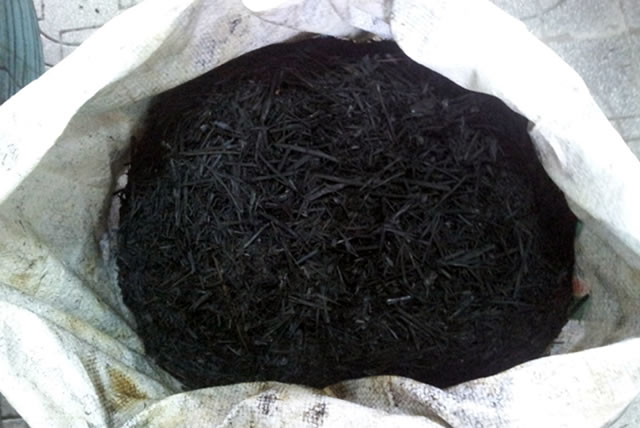 Figure 4. Biochar produced from rice straw.Biochar, a carbon-rich product, is used as soil amendment to improve soil productivity, carbon storage, and filtration of percolating soil water (Lehmann and Joseph 2009). It is produced by the thermal decomposition of organic materials or biomass under a limited supply of oxygen at temperatures from 500 to 700°C.
Figure 4. Biochar produced from rice straw.Biochar, a carbon-rich product, is used as soil amendment to improve soil productivity, carbon storage, and filtration of percolating soil water (Lehmann and Joseph 2009). It is produced by the thermal decomposition of organic materials or biomass under a limited supply of oxygen at temperatures from 500 to 700°C.
An advanced carbonization technology, called hydrothermal carbonization (HTC), has been developed recently. The HTC of lignocellulosic biomass is a process that completely breaks down the plant cell wall and allows the rapid conversion of biomass into a carbon-rich and lignine-like product (hydrochar). Hydrochar has a considerably higher heating value than the raw material (Ling-Ping et al 2012).
Using rice straw to produce biochar (Figure 4) has huge potential. Also, carbon sequestration in the application of biochar helps lessen the threat of climate change caused by GHG emissions in the atmosphere. Reduction in emissions associated with using biochar as soil amendment is higher than the fossil fuel offset in its use as fuel (Gaunt and Lehmann 2008).
Despite its huge potential, however, the processing of biochar requires energy for carbonization and for transportation of rice straw and biochar products. Until now, there is still a need for studies that demonstrate the feasibility of biochar production from rice straw in terms of energy balance and economic benefits.
Using rice straw for livestock feed
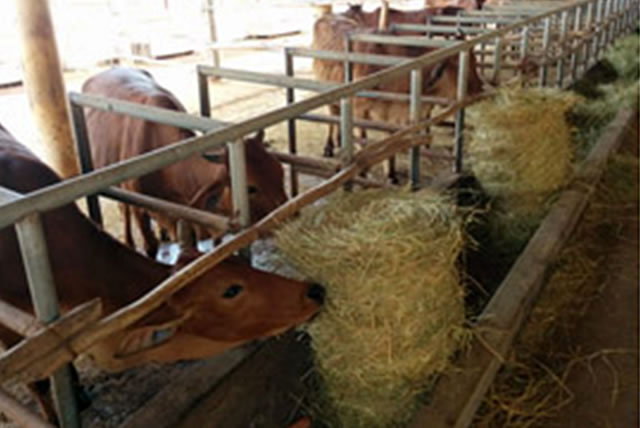 Figure 5. Using rice straw as livestock feed.Using rice straw for cattle feed (Figure 5) is common in Southeast Asia. On average, the daily maximum intake of rice straw by ruminants is about 1.0 to1.2 kg per 100 kg live weight (Devendra and Thomas 2002).
Figure 5. Using rice straw as livestock feed.Using rice straw for cattle feed (Figure 5) is common in Southeast Asia. On average, the daily maximum intake of rice straw by ruminants is about 1.0 to1.2 kg per 100 kg live weight (Devendra and Thomas 2002).
However, rice straw in its raw and unsupplemented form has low amounts of digestible energy and essential nutrients for growing cattle. Of the parts of rice straw, the stems are more digestible as they have lower silica content (Drake et al 2002) compared to the leaves, which have higher silica content and are considered poor feed for animals (Singh and Sidhu 2014). Therefore, the rice crop should be cut as close to the ground as possible if the straw is to be fed to livestock. Nutrient amendment is often done by treating the rice straw with urea, which is safer and more practical to use than anhydrous or aqueous ammonia. Urea becomes a source of nitrogen (crude protein), of which rice straw is deficient. Another strategy to improve the digestibility of cellulose is to treat the rice straw with sodium hydroxide or ammonia.
Using rice straw for energy production
Rice straw can be used to generate fuel, heat, or electricity through thermal, chemical, or bioprocesses (Figure 6).
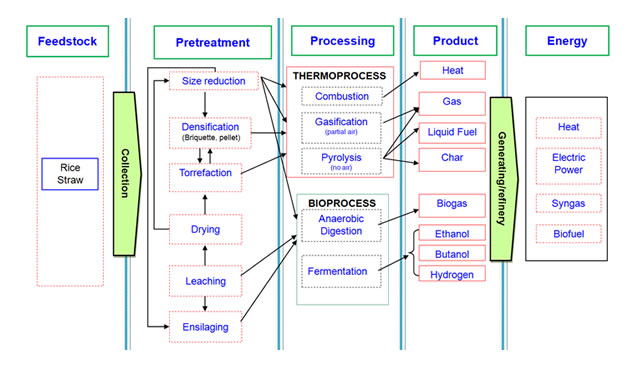
Figure 6. Potential energy conversion processes of rice straw.
However, there are still barriers to using rice straw for energy conversion:
- The high silica content of rice straw causes the components in processing machines, such as the chopper or grinder, to wear out. The content of volatile matter in rice straw is higher than that in wood and much higher than in coal, whereas fixed carbon is much lower than in coal. Ash content in rice straw is much higher than that in wood and coal (Jenkins et al 1996, Jenkins 1998).
- The high content of ash, alkali, and potassium in rice straw causes agglomeration, fouling, and melting in the components of combustors or boilers (Baker 2000, Jeng et al 2012).
- The lignin walls in rice straw hampers digestibility, which reduces the efficiency of bio-energy conversion processes (Klass 1998).
Case study on the feasibility of a rice straw combustion power plant
A study on the feasibility of establishing a 1-megawatt rice straw power plant at the International Rice Research Institute (IRRI) was recently conducted by the institute and ENERTIME Company (Guillemot et al 2014). The developed system (Figure 7) uses an advanced technology for biomass combustion, which is the Organic Rankine Cycle (ORC). An ORC turbo-machine generates electricity using thermal energy from thermal oil (or saturated steam) that is generated from the combustion of biomass in a boiler. This thermal exchanger transfers energy from the oil to the organic working fluid, heating the fluid and causing it to vaporize. The oil (or steam) is condensed and cooled before it circulates back to the boiler. The vaporized working fluid fuels the turbine, which then sets the asynchronous generator in motion. The disadvantage of having a relatively low efficiency is compensated by the fact that the ORC process can deal easily with varying temperatures, which is an advantage when dealing with difficult fuels like rice straw.
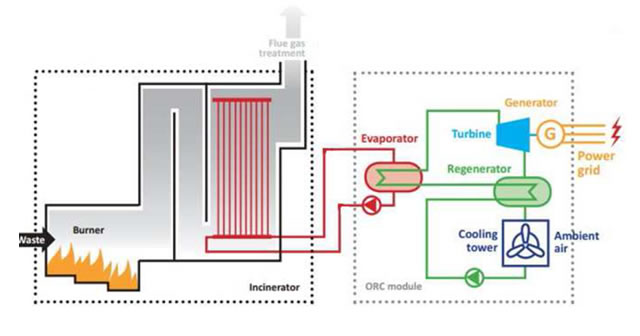
Figure 7. Schematic diagram of a 1-megawatt power plant with ORC. Source: Guillemot et al 2014.
Using rice straw for anaerobic digestion (biogas production)
Anaerobic digestion (AD) is a potential small-scale energy conversion technology for rice straw which is used to generate biogas fuel for cooking, heating air for drying, or for generating electricity.
Small-scale anaerobic digestion using rice straw
A case study on using rice straw for small-scale anaerobic digestion (AD) was conducted by Can Tho University in Vietnam in 2013. Rice straw was mixed with manure from livestock at a rate of 50–80%. The amount of biogas yielded was about 600 liters per kg of straw, which had a methane content of 50–55%. Figure 8 shows a single-stage AD system for rice straw and pig dung developed by Can Tho University in 2013.
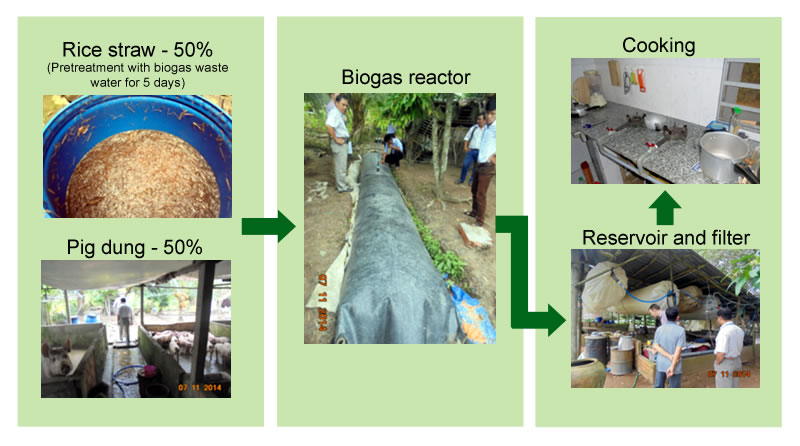
Figure 8. Small-scale, single-stage AD system for rice straw and pig dung in Can Tho City, Vietnam.
There were still many problems encountered during the study, such as rice straw sticking to the digester and the unstable gas generation.
A small-scale batch-AD system using rice straw is being studied at the Punjab Agricultural University (PAU) in India. This system includes the main components of a batch-digester and a gas holder or reservoir (Figure 9). Both these components are built using cement materials. The cost of the whole system is INR 150,000, including the digester, gas holder, and other supporting components such as pipes and valves. This AD technology was piloted in 2012, with five models distributed around Punjab.
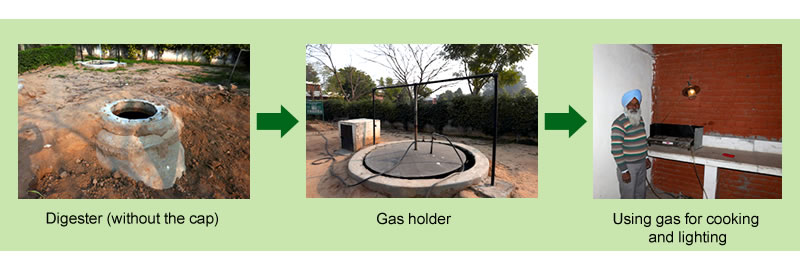
Figure 9. Batch-AD system using rice straw and cow dung.
Rice straw and cattle dung are arranged layer by layer in the digester. A layer of rice straw is first spread on the digester then it is covered by a layer of cattle dung. This is repeated over again; the top layer must be cattle dung to cover all substrates. The ratio of the layers of rice straw to cattle dung is 4:1 based on the weight with the specified moisture content (MC). Feedstock with 1.6 tons of chopped straw (15–18% MC) and 0.4 ton of cow dung (30–40% MC) is fed into a batch digester with a retention time of 100–120 days. Biogas is generated on the 7th day after feeding, with average yield of 4–5 m3 biogas per day in about 100 days. Methane content is about 65%. In addition to the outputs, about 0.4 ton of digestate is obtained and used as organic fertilizer.
Industrial-scale anaerobic digestion using rice straw
There is limited anaerobic digestion (AD) using rice straw. A case business model was assessed in 2016 in Punjab, India. This biogas power plant using rice straw feedstock, Sampurn Agri Ventures Pvt. Ltd. (http://sampurn.in/), is located in Fazilka, southwest of Punjab. Figure 10 shows the process route of this power plant. Rice straw is fed into a chopper to be sheared off. The sheared rice straw is then mixed with cow dung on a ratio of 20:1 based on total solid matter (TS). This mixed substrate is then pumped into the first-stage digester, which is maintained at 35°C. Retention time (RT) of the substrate in the first anaerobic digestion (AD) stage is 20 days, after that it is transferred to the second-stage digester. Temperature in the second-stage digester is also maintained at 35°C with an RT of 20 days. The biogas is collected through a reservoir, and then converted to electric power by a generator. The digestate produced after anaerobic digestion is used in processing liquid and solid organic fertilizers. The liquid fertilizer is produced by activating the bacteria in the digestate under aerobic conditions at 45°C, whereas the solid fertilizer is obtained by pressing the digestate to separate the solid from the slurry. Part of the slurry will be used in mixing chopped straw and cow dung.
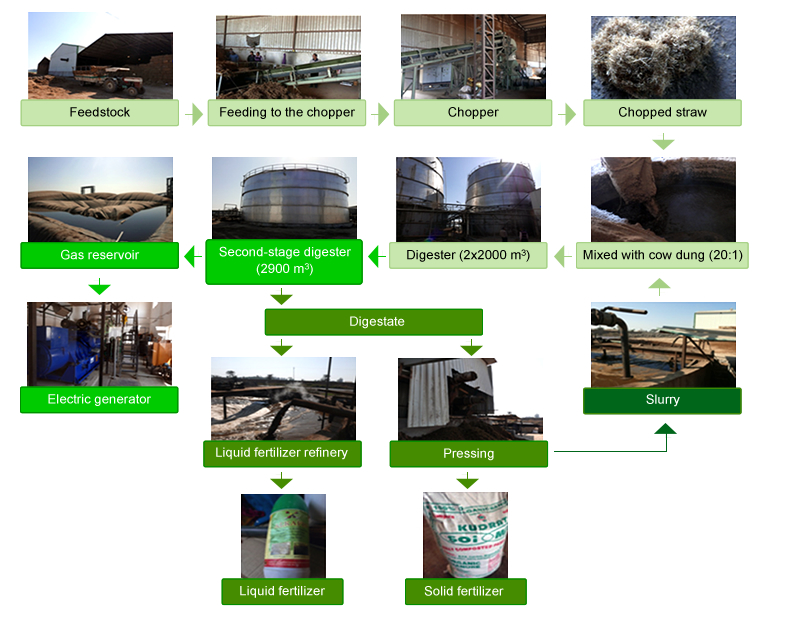
Figure 10. Process route of the anaerobic digestion power plant in Fazilka, Punjab, India.
Rice straw is mixed with cow dung regularly with a ratio of 95% and 5%, respectively, based on total solid matter (TS). The pH of the AD substrate is maintained from 7 to 7.5 by adjusting the amount of rice straw or cow dung fed. If the pH drops, the feeding controller will reduce rice straw and increase cow dung, and vise versa. This AD plant has a capacity of 1.2 MWe with its regular operation of 80% of the capacity. With its consumption of 15,000 tons of straw per year, this plant generates about 18 MWh per to grid-electricity. It self-consumes about 3 MWh per day.
References
Baker R. 2000. Biomass fuel leaching for the control of fouling, slagging, and agglomeration in biomass power generation. PhD Dissertation, University of Califonia.
Devendra C, Thomas D. 2002. Crop-animal interactions in mixed farming systems in Asia. Agric. Syst. 71:27–40.
Drake D, Nader G, Forero L. 2002. Feeding rice straw to cattle. Publication 8079. University of California. Division of Agriculture and Natural Resources. http://anrcatalog.ucdavis.edu.
Gaunt JL, Lehmann J. 2008. Energy balance and emissions associated with biochar sequestration and pyrolysis bioenergy production. Environ. Sci. Technol. 42(11):4152–4158.
Guillemot A, Bruant R, Pasquiou V, Boucher E. 2014. Feasibility study for the implementation of two ORC power plants of 1 MWe each using rice straw as a fuel in the context of a public-private partnership with the institutions PhilRice and UPLB. Courbevoie, France: ENERTIME.
Jeng Shiun Lim, Zainuddin Abdul Manan, Sharifah Rafidah Wan Alwi, Haslenda Hashim. 2012. A review on utilisation of biomass from rice industry as a source of renewable Energy. Renew. Sust. Energ. Rev. 16:3084–3094.
Jenkins BM. 1998. Physical properties of biomass. In: Kitani O, Hall CW, editors. Biomass Handbook, Chapter 5.2. Gordon and Breach, New York.
Jenkins BM, Bakker RR, Wei JB. 1996. On the properties of washed straw. Biomass Bioenergy 10(4):177–200.
Klass, L., 1998. Biomass for Renewable Energy and Fuels. Entech International, Inc. Barrington, Illinois, United States.
Lehmann J, Joseph S. 2009. Biochar for Environmental Management: An Introduction. Biochar Environ. Manage. p 1–12.
Ling-Ping Xiao, Zheng-Jun Shi, Feng Xu, Run-Cang Sun, 2012. Hydrothermal carbonization of lignocellulosic biomass. Bioresource Technology 118 (2012): 619–623.
Ngo TTT. 2011. Comparative assessment of using rice straw for rapid composting and straw mushroom production in mitigating greenhouse gas emissions in Mekong Delta, Vietnam and Central Luzon, Philippines. Unpublished dissertation for PhD in Environmental Science. SESAM, UPLB.
Reyes RG. 2000. Indoor cultivation of paddy straw mushroom, Volvariella volvacea, in crates. Center for Tropical Mushroom Research and Development, Dept. of Biological Sciences, College of Arts and Sciences, CLSU, Nueva Ecija, Philippines. Mycologist 14(4).
Singh Y, Sidhu HS. 2014. Management of cereal crop residues for sustainable rice-wheat production system in the Indo-gangetic plains of India. Proc. Indian Natn. Sci. Acad. 80(1):95–114.
Zhang R, Li X, Fadel JG. 2002. Oyster mushroom cultivation with rice and wheat straw. Bioresour. Technol. 82:277–284.

